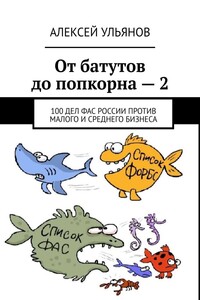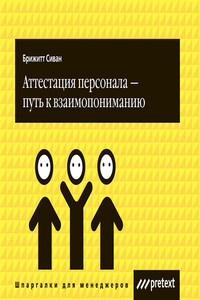Успеть за 120 минут. Как создать условия для максимально эффективной работы [заметки]
1
Benjamin Franklin, «Autobiography of Benjamin Franklin» (без копирайта, опубликовано 1 января 1790 г.), https://itun.es/us/xZiNx.l.
2
Benjamin Franklin, «I Sing My Plain Country Joan, 1742,» Founders Online, National Archives, последнее изменение 1 декабря 2014 г., http://founders.archives.gov/documents/Franklin/01-02-02-0087.
3
«Benjamin Franklin», www.biography.com/people/benjamin-franklin-9301234.
4
Более полное определение «воплощенного познания» см. в предисловии к специальному выпуску журнала, посвященного этой теме, которое я редактировал вместе с Артом Маркманом: Joshua I. Davis and Arthur B. Markman, «Embodied Cognition as a Practical Paradigm: Introduction to the Topic, the Future of Embodied Cognition,» Topics in Cognitive Science 4, no. 4 (2012): 685–91. Подборка статей и другие источники по теории воплощенного познания см. по адресу www.embodiedmind.org.
5
Dana R. Carney, Amy J. Cuddy, and Andy J. Yap, «Power Posing: Brief Nonverbal Displays Affect Neuroendocrine Levels and Risk Tolerance,» Psychological Science 21, no. 10 (2010): 1363–68; Pranjal H. Mehta and R. A. Josephs, «Testosterone and Cortisol Jointly Regulate Dominance: Evidence for a Dual-Hormone Hypothesis,» Hormones and Behavior 58 (2010): 898–906.
6
Jesse Chandler and Norbert Schwarz, «How Extending Your Middle Finger Affects Your Perception of Others: Learned Movements Influence Concept Accessibility,» Journal of Experimental Social Psychology 45, no. 1 (January 2009): 123–28.
7
Josh Davis, Maite Balda, David Rock, Paul McGinniss, and Lila Davachi, «The Science of Making Learning Stick: An Update to the AGES Model,» NeuroLeadership Journal 5 (2014). Обратите внимание: не все специалисты по воплощенному познанию отнесли бы этот пример к воплощенному познанию. Однако я намеренно поместил его сюда, чтобы читатель видел, что такие нейробиологические данные иллюстрируют идею об отличии человеческого тела от компьютеров и механизмов.
8
Дахигг Ч. Сила привычки. Почему мы живем и работаем именно так, а не иначе. – М.: Карьера Пресс, 2015.
9
Susan T. Fiske and Shelley E. Taylor, Social Cognition: From Brains to Culture (Thousand Oaks, CA: Sage Publications, 2013).
10
«Trance,» онлайн-версия словаря Merriam-Webster, версия от 14 сентября 2014 г., www.merriam-webster.com/dictionary/trance.
11
Ezequiel Morsella, «The Function of Phenomenal States: Supramodular Interaction Theory,» Psychological Review 112, no. 4 (2005): 1000–21. Данная работа была первоначально опубликована, когда автор работал в Йельском университете, затем он организовал лабораторную группу в Университете штата в Сан-Франциско.
12
John G. Kerns et al., «Anterior Cingulate Conflict Monitoring and Adjustments in Control,» Science 303, no. 5660 (2004): 1023–26; и Matthew M. Botvinick, Jonathan D. Cohen, and Cameron S. Carter, «Conflict Monitoring and Anterior Cingulate Cortex: An Update,» Trends in Cognitive Sciences 8, no. 12 (2004): 539–46.
13
Naomi I. Eisenberger and Matthew D. Lieberman, «Why Rejection Hurts: A Common Neural Alarm System for Physical and Social Pain,» Trends in Cognitive Sciences 8, no. 7 (2004): 294–300.
14
Kathleen D. Vohs and Brandon J. Schmeichel, «Self-Regulation and Extended Now: Controlling the Self Alters the Subjective Experience of Time,» Journal of Personality and Social Psychology 85, no. 2 (2003): 217–30.
15
Стивен Р. Кови. Семь навыков высокоэффективных людей. – М.: Альпина Паблишер, 2015.
16
Бенджамин Франклин, чтобы напомнить себе о важных делах, по утрам спрашивал себя: «Что хорошего я сделаю сегодня?». Не знаю, возвращался ли он к этой мысли в течение дальнейшего дня, но идея мне кажется похожей. Отрывок из автобиографии Бенджамина Франклина, https://itun.es/us/xZiNx.l.
17
Nira Liberman and Yaacov Trope, «The Psychology of Transcending the Here and Now,» Science 322, no. 5905 (2008): 1201–5.
18
Gal Zauberman et al., «Discounting Time and Time Discounting: Subjective Time Perception and Intertemporal Preferences,» Journal of Marketing Research 46, no. 4 (2009): 543–56.
19
Aleksandra Luszczynska, Anna Sobczyk, and Charles Abraham, «Planning to Lose Weight: Randomized Controlled Trial of an Implementation Intention Prompt to Enhance Weight Reduction Among Overweight and Obese Women,» Health Psychology 26, no. 4 (2007): 507–12.
20
Thomas L. Webb et al., «Effective Regulation of Affect: An Action Control Perspective on Emotion Regulation,» European Review of Social Psychology 23, no. 1 (2012): 143–86.
21
Janine Chapman, Christopher J. Armitage, and Paul Norman, «Comparing Implementation Intention Interventions in Relation to Young Adults' Intake of Fruit and Vegetables,» Psychology and Health 24, no. 3 (2009): 317–32.
22
Peter M. Gollwitzer, «Implementation Intentions: Strong Effects of Simple Plans,» American Psychologist 54, no. 7 (1999): 493–503; и Peter M. Gollwitzer and Paschal Sheeran, «Implementation Intentions and Goal Achievement: A Meta-Analysis of Effects and Processes,» Advances in Experimental Social Psychology 38 (2006): 69–119.
23
Michael L. Anderson, «Neural Reuse: A Fundamental Organizational Principle of the Brain,» Behavioral and Brain Sciences 33, no. 04 (2010): 245–66; and Michael L. Anderson, Michael J. Richardson, and Anthony Chemero, «Eroding the Boundaries of Cognition: Implications of Embodiment,» Topics in Cognitive Science 4, no. 4 (2012): 717–30.
24
M. Brouziyne and C. Molinaro, «Mental Imagery Combined with Physical Practice of Approach Shots for Golf Beginners,» Perceptual and Motor Skills 101, no. 1 (2005): 203–11.
25
Sonal Arora et al., «Mental Practice Enhances Surgical Technical Skills: A Randomized Controlled Study,» Annals of Surgery 253, no. 2 (2011): 265–70.
26
Mike Knudstrup, Sharon L. Segrest, and Amy E. Hurley, «The Use of Mental Imagery in the Simulated Employment Interview Situation,» Journal of Managerial Psychology 18, no. 6 (2003): 573–91.
27
Vinoth K. Ranganathan et al., «From Mental Power to Muscle Power – Gaining Strength by Using the Mind,» Neuropsychologia 42, no. 7 (2004): 944–56.
28
Elliot T. Berkman and Jordan S. Miller-Ziegler, «Imaging Depletion: fMRI Provides New Insights into the Processes Underlying Ego Depletion,» Social Cognitive and Affective Neuroscience 8, no. 4 (2012): 359–61; и Michael Inzlicht and Brandon J. Schmeichel, «What Is Ego Depletion? Toward a Mechanistic Revision of the Resource Model of Self-Control,» Perspectives on Psychological Science 7, no. 5 (2012): 450–63.
29
Jessica R. Cohen and Matthew D. Lieberman, «The Common Neural Basis of Exerting Self-Control in Multiple Domains,» in Self Control in Society, Mind, and Brain, ed. Ran R. Hassin, Kevin N. Ochsner, and Yaacov Trope (New York: Oxford University Press, 2010), 141–60; Matthew D. Lieberman, «The Brain's Braking System (and How to 'Use Your Words' to Tap into It),» NeuroLeadership Journal 2 (2009): 9–14; Elliot T. Berkman, Lisa Burklund, and Matthew D. Lieberman, «Inhibitory Spillover: Intentional Motor Inhibition Produces Incidental Limbic Inhibition via Right Inferior Frontal Cortex,» Neuroimage 47, no. 2 (2009): 705–12; and Michael Inzlicht, Elliot Berkman, and Nathaniel Elkins-Brown, «The Neuroscience of 'Ego Depletion' or: How the Brain Can Help Us Understand Why Self-Control Seems Limited,» in Social Neuroscience: Biological Approaches to Social Psychology, ed. Eddie Harmon-Jones and Michael Inzlicht (New York: Psychology Press, 2015). Inzlicht, Berkman и Elkins-Brown указывают, что для самоконтроля необходимы несколько участков мозга в разных ролях (например, вентролатеральная часть префронтальной коры особенно важна для самоподавления). Читатели, которых интересует нейробиологический аспект самоконтроля, могут обратиться за подробностями к указанной главе в Social Neuroscience.
30
Inzlicht, Berkman, and Elkins-Brown (см. предыдущее примечание) отмечают, что эти данные наилучшим образом понимаются как свидетельства того, что самоконтроль требует усилий, а через некоторое время различные участки мозга, включенные в процесс, задействуются меньше, поскольку у нас пропадает мотивация продолжать затратную деятельность. Однако авторы описывают исследование, показывающее, что при достаточной мотивации (например, при наличии положительных стимулов или веры в то, что мы можем продержаться дольше) мозг способен длительно заниматься самоконтролем. Конкретная продолжительность времени неизвестна.
31
В качестве альтернативы применению силы воли для отказа от чего-либо (например, от плюшки) можно попытаться не думать о плюшке, тогда отказ от нее не потребует самоконтроля. Вот один из способов этого добиться. Перед тем как подумать, что бы съесть, переосмыслите саму цель: вы завтракаете для того, чтобы хорошо себя чувствовать с момента завтрака до обеда. Плюшки дадут хорошее самочувствие всего на несколько минут, через час-другой вы устанете или проголодаетесь. Такое переосмысление приводит к тому, что вы и не съедаете плюшку, и не тратите самоконтроль на отказ от нее, поскольку с этой точки зрения плюшки совершенно непривлекательны. Этот способ отношения к еде я более подробно рассматриваю в стратегии 4.
32
Roy F. Baumeister and John Tierney, Willpower: Rediscovering the Greatest Human Strength (New York: Penguin, 2011), 99.
33
Kathleen D. Vohs et al., «Making Choices Impairs Subsequent Self-Control: A Limited-Resource Account of Decision Making, Self-Regulation, and Active Initiative,» Journal of Personality and Social Psychology 94, no. 5 (2008): 883–98.
34
Shaheem Reid с дополнительными сведениями от Sway Calloway, «All Eyes on Beyoncе,» MTV.com, www.mtv.com/bands/b/beyonce/news_feature_081406/.
35
Eddie Harmon-Jones et al., «The Effect of Personal Relevance and Approach-Related Action Expectation on Relative Left Frontal Cortical Activity,» Psychological Science 17, no. 5 (2006): 434–40.
36
Each of these findings regarding sadness is reviewed in Joseph P. Forgas, «Don't Worry, Be Sad! On the Cognitive, Motivational, and Interpersonal Benefits of Negative Mood,» Current Directions in Psychological Science 22, no. 3 (2013): 225–32.
37
Matthijs Baas, Carsten K. W. De Dreu, and Bernard A. Nijstad, «A Meta-Analysis of 25 Years of Mood-Creativity Research: Hedonic Tone, Activation, or Regulatory Focus?» Psychological Bulletin 134, no. 6 (2008): 779–806.
38
Maya Tamir, «Don't Worry, Be Happy? Neuroticism, Trait-Consistent Affect Regulation, and Performance,» Journal of Personality and Social Psychology 89, no. 3 (2005): 449–61. По данным этого исследования, описанные эффекты наиболее заметно проявлялись у более невротичных испытуемых.
39
Karuna Subramaniam et al., «A Brain Mechanism for Facilitation of Insight by Positive Affect,» Journal of Cognitive Neuroscience 21, no. 3 (2009): 415–32.
40
Baas, De Dreu, and Nijstad, «A Meta-Analysis of 25 Years,» 779–806; and Alice M. Isen, Kimberly A. Daubman, and Gary P. Nowicki, «Positive Affect Facilitates Creative Problem Solving,» Journal of Personality and Social Psychology 52, no. 6 (1987): 1122–31. В частности, статья Baas, De Dreu и Nijstad показывает, что подходо-ориентированные и относительно более активные позитивные эмоции способствуют креативности. Другие положительные эмоции, например чувство спокойствия или расслабленности, могут не оказывать такое воздействие.
41
Suzanne K. Vosburg, «The Effects of Positive and Negative Mood on Divergent-Thinking Performance,» Creativity Research Journal 11, no. 2 (1998): 165–72; и Norbert Schwarz, Herbert Bless, and Gerd Bohner, «Mood and Persuasion: Affective States Influence the Processing of Persuasive Communications,» Advances in Experimental Social Psychology 24 (1991): 161–99. Позитивный настрой может вести к «удовлетворенности» – склонности останавливаться на удовлетворительных решениях и ответах и не стремиться к идеальным. В свете ранее цитированных исследований, указывающих на положительное влияние позитивного настроя на креативность, интересно утверждение Восбурга, что существует как минимум несколько видов ситуаций, в которых позитивный настрой не усиливает креативность, например при необходимости идеального или оптимального креативного решения.
42
Guido Hertel et al., «Mood Effects on Cooperation in Small Groups: Does Positive Mood Simply Lead to More Cooperation?» Cognition and Emotion 14, no. 4 (2000): 441–72.
43
Joseph P. Forgas, «On Feeling Good and Getting Your Way: Mood Effects on Negotiator Cognition and Bargaining Strategies,» Journal of Personality and Social Psychology 74, no. 3 (1998): 565–77.
44
Martin E. P. Seligman and Mihaly Csikszentmihalyi, «Positive Psychology: An Introduction,» American Psychologist 55, no. 1 (2000): 5–14. При чтении отчета об исследовании сложно понять, какие положительные эмоции, в отличие от отрицательных, оказывают неодинаковый эффект. В некоторых исследованиях указаны радость, удовольствие, удовлетворение, комфортная расслабленность, гордость и др., однако во многих случаях просто упоминаются положительные эмоции вообще. Подозреваю, что причиной может быть более активное изучение негативных психологических аспектов, чем позитивных. Независимо от возможной причины сейчас резоннее говорить, что такой эффект оказывают положительные эмоции – такие как радость, счастье, удовольствие или общее положительное ощущение.
45
Некоторые исследователи различают эмоции (более кратковременные и связанные с конкретным поводом) и настроения (более долговременные и не привязанные к определенной причине). Я использую эти термины взаимозаменяемо, поскольку независимо от продолжительности и причины описанный эффект, насколько я понимаю, будет сходным.
46
Martin P. Paulus, «The Breathing Conundrum – Interoceptive Sensitivity and Anxiety,» Depression and Anxiety 30, no. 4 (2013): 315–20; and A. D. Craig, «Interoception: The Sense of the Physiological Condition of the Body,» Current Opinion in Neurobiology 13, no. 4 (2003): 500–5.
47
F. A. Bainbridge, «The Relation Between Respiration and the Pulse-Rate,» Journal of Physiology 54, no. 3 (1920): 192–202.
48
Dianne M. Tice et al., «Restoring the Self: Positive Affect Helps Improve Self-Regulation Following Ego Depletion,» Journal of Experimental Social Psychology 43, no. 3 (2007): 379–84.
49
Amber Brooks and Leon Lack, «A Brief Afternoon Nap Following Nocturnal Sleep Restriction: Which Nap Duration Is Most Recuperative?» Sleep 29, no. 6 (2006): 831–40. Это исследование изучало людей, получавших возможность кратковременного сна после долгого периода принудительного бодрствования. На работе мы не всегда находимся в состоянии недосыпания, но, если недостаток сна ощутим, кратковременный сон может помочь вам больше, чем вы думаете.
50
M. I. Posner, «Attention: The Mechanisms of Consciousness,» Proceedings of the National Academy of Sciences 91, no. 16 (1994): 7398–403.
51
Christian Balkenius, «Attention, Habituation, and Conditioning: Toward a Computational Model,» Cognitive Science Quarterly 1, no. 2 (2000): 171–204.
52
Каким образом книга или компьютерная игра заставляют нас забыться на долгое время? Подозреваю, что в таких случаях наше внимание удерживают сюжет или последовательность приключений. Авторы, вероятно, осознанно используют тот факт, что наше внимание настроено реагировать на помехи.
53
Daniel M. Wegner et al., «Paradoxical Effects of Thought Suppression,» Journal of Personality and Social Psychology 53, no. 1 (1987): 5–13. В исходном исследовании на эту тему белый медведь приводился в качестве примера. Я повторил пример как дань уважения к авторам.
54
Allan M. Collins and Elizabeth F. Loftus, «A Spreading-Activation Theory of Semantic Processing,» Psychological Review 82, no. 6 (1975): 407–28.
55
По неясным причинам научная литература редко дает ответы на вопрос, сколько времени в среднем люди могут заниматься одним и тем же. Вероятно, это слишком зависит от контекста.
56
Elizabeth R. Valentine and Philip L. G. Sweet, «Meditation and Attention: A Comparison of the Effects of Concentrative and Mindfulness Meditation on Sustained Attention,» Mental Health, Religion, and Culture 2, no. 1 (1999): 59–70. В этом исследовании среди тех, кто занимался медитацией, практикующие «осознанную» медитацию показывали лучшие результаты, чем занимавшиеся «сосредоточенной» медитацией.
57
Jonathan Smallwood and Jessica Andrews-Hanna, «Not All Minds That Wander Are Lost: The Importance of a Balanced Perspective on the Mind-Wandering State,» Frontiers in Psychology 4 (2013): 441.
58
Benjamin Baird et al., «Inspired by Distraction: Mind Wandering Facilitates Creative Incubation,» Psychological Science 23, no. 10 (2012): 1117–22.
59
Benjamin Baird, Jonathan Smallwood, and Jonathan W. Schooler, «Back to the Future: Autobiographical Planning and the Functionality of Mind-Wandering,» Consciousness and Cognition 20, no. 4 (2011): 1604–11.
60
Jonathan Smallwood, Louise Nind, and Rory C. O'Connor, «When Is Your Head At? An Exploration of the Factors Associated with the Temporal Focus of the Wandering Mind,» Consciousness and Cognition 18, no. 1 (2009): 118–25.
61
Jon Kabat-Zinn, «An Outpatient Program in Behavioral Medicine for Chronic Pain Patients Based on the Practice of Mindfulness Meditation: Theoretical Considerations and Preliminary Results,» General Hospital Psychiatry 4, no. 1 (1982): 33–47; и Jon Kabat-Zinn, Full Catastrophe Living (Revised Edition): Using the Wisdom of Your Body and Mind to Face Stress, Pain, and Illness (New York: Random House, 2013).
62
Maryanna D. Klatt, Janet Buckworth, and William B. Malarkey, «Effects of Low-Dose Mindfulness-Based Stress Reduction (MBSR-LD) on Working Adults,» Health, Education, and Behavior 36, no. 3 (2009): 601–14.
63
Philippe R. Goldin and James J. Gross, «Effects of Mindfulness-Based Stress Reduction (MBSR) on Emotion Regulation in Social Anxiety Disorder,» Emotion 10, no. 1 (2010): 83–91.
64
Linda E. Carlson and Sheila N. Garland, «Impact of Mindfulness-Based Stress Reduction (MBSR) on Sleep, Mood, Stress, and Fatigue Symptoms in Cancer Outpatients,» International Journal of Behavioral Medicine 12, no. 4 (2005): 278–85.
65
Scott R. Bishop et al., «Mindfulness: A Proposed Operational Definition,» Clinical Psychology: Science and Practice 11, no. 3 (2004): 230–41. Бишоп с соавторами дает такое определение «осознанности»: «Первый компонент связан с саморегуляцией внимания: она поддерживается на уровне непосредственного опыта, тем самым обеспечивая повышенное осознание ментальных событий в данный момент времени. Второй компонент связан с настройкой на определенную ориентацию человека по отношению к его опыту в данный момент времени – ориентацию, которая характеризуется любопытством, открытостью и одобрением» (с. 232).
66
Andy Clark, Being There: Putting Brain, Body, and World Together Again (Cambridge, MA: MIT Press, 1997); Antonio Damasio, Descartes' Error: Emotion, Reason, and the Human Brain (New York: HarperCollins, 1994); George Lakoff and Mark Johnson, Philosophy in the Flesh: The Embodied Mind and Its Challenge to Western Thought (New York: Basic Books, 1999).
Идея о том, что тело и сознание сложно взаимосвязаны, интуитивно понятна многим, но менее привычна в философских кругах. Из чтения литературы по этой теме становится ясно: представление о том, что сознание и тело действуют в основном по отдельности, есть плод изрядного количества непроверенных домыслов. Думаю, что такие домыслы влияют и на то, что мы считаем полезным занятием, – например, физические упражнения.
67
Stanley Schachter and Jerome E. Singer, «Cognitive, Social, and Physiological Determinants of Emotional State,» Psychological Review 69, no. 5 (1962): 379–99.
68
Nelson Mandela, Long Walk to Freedom: The Autobiography of Nelson Mandela (New York: Little, Brown and Company, 1994), 490.
69
Lot Verburgh et al., «Physical Exercise and Executive Functions in Preadolescent Children, Adolescents, and Young Adults: A Meta-Analysis,» British Journal of Sports Medicine 48, no. 12 (2014): 973–79.
70
Shannan E. Gormley et al., «Effect of Intensity of Aerobic Training on VO2max,» Medicine and Science in Sports and Exercise 40, no. 7 (2008): 1336–43.
71
Hiroki Yanagisawa, Ippeita Dan, Daisuke Tsuzuki, Morimasa Kato, Masako Okamoto, Yasushi Kyutoku, and Hideaki Soya, «Acute Moderate Exercise Elicits Increased Dorsolateral Prefrontal Activation and Improves Cognitive Performance with Stroop Test,» Neuroimage 50, no. 4 (2010): 1702–10.
72
Kevin C. O'Leary et al., «The Effects of Single Bouts of Aerobic Exercise, Exergaming, and Videogame Play on Cognitive Control,» Clinical Neurophysiology 122, no. 8 (2011): 1518–25.
73
Berit Inkster and Brian M. Frier, «The Effects of Acute Hypoglycaemia on Cognitive Function in Type 1 Diabetes,» British Journal of Diabetes and Vascular Disease 12, no. 5 (2012): 221–26.
74
Franciele R. Figueira et al., «Aerobic and Combined Exercise Sessions Reduce Glucose Variability in Type 2 Diabetes: Crossover Randomized Trial,» PLoS ONE8, no. 3 (2013): e57733.
75
Steven J. Petruzzello et al., «A Meta-Analysis on the Anxiety-Reducing Effects of Acute and Chronic Exercise: Outcomes and Mechanisms,» Sports Medicine 11, no. 3 (1991): 143–82.
76
Eli Puterman et al., «The Power of Exercise: Buffering the Effect of Chronic Stress on Telomere Length,» PLoS ONE5, no. 5 (2010): e10837.
77
Justy Reed and Deniz S. Ones, «The Effect of Acute Aerobic Exercise on Positive Activated Affect: A Meta-Analysis,» Psychology of Sport and Exercise 7, no. 5 (2006): 477–514.
78
Reed and Ones, «The Effect of Acute Aerobic Exercise,» 477–514.
79
Bryan D. Loy, Patrick J. O'Connor, and Rodney K. Dishman, «The Effect of a Single Bout of Exercise on Energy and Fatigue States: A Systematic Review and Meta-Analysis,» Fatigue: Biomedicine, Health and Behavior 1, no. 4 (2013): 223–42.
80
Alexa Hoyland, Clare L. Lawton, and Louise Dye, «Acute Effects of Macronutrient Manipulations on Cognitive Test Performance in Healthy Young Adults: A Systematic Research Review,» Neuroscience and Biobehavioral Reviews 32, no. 1 (2008): 72–85.
81
Edward Leigh Gibson, «Effects of Energy and Macronutrient Intake on Cognitive Function Through the Lifespan,» Proceedings of the Latvian Academy of Sciences, Section B, Natural, Exact, and Applied Sciences 67, nos. 4–5 (2013): 303–447.
82
Karina Fischer et al., «Cognitive Performance and Its Relationship with Postprandial Metabolic Changes After Ingestion of Different Macronutrients in the Morning,» British Journal of Nutrition 85, no. 03 (2001): 393–405.
83
Gibson, «Effects of Energy and Macronutrient Intake,» 303–447.
84
David Benton, «Carbohydrates and the Cognitive Performance of Children,» Carbohydrate News, Canadian Sugar Institute Nutrition Information Service, 2012, www.sugar.ca/SUGAR/media/Sugar-Main/PDFs/CarbNews2012_ENG-qxp_FINAL.pdf.
85
Hayley Young and David Benton, «The Glycemic Load of Meals, Cognition, and Mood in Middle and Older Aged Adults with Differences in Glucose Tolerance: A Randomized Trial,» e-SPEN Journal 9, no. 4 (2014): e147–54.
86
Simon B. Cooper et al., «Breakfast Glycaemic Index and Cognitive Function in Adolescent School Children,» British Journal of Nutrition 107, no. 12 (2012): 1823–32.
87
Paul Hewlett, Andrew Smith, and Eva Lucas, «Grazing, Cognitive Performance, and Mood,» Appetite 52, no. 1 (2009): 245–48.
88
Dale A. Schoeller, «Changes in Total Body Water with Age,» American Journal of Clinical Nutrition 50, no. 5 (November 1, 1989): 1176–81.
89
Ana Adan, «Cognitive Performance and Dehydration,» Journal of the American College of Nutrition 31, no. 2 (2012): 71–78.
90
Lawrence E. Armstrong et al., «Mild Dehydration Affects Mood in Healthy Young Women,» Journal of Nutrition 142, no. 2 (2012): 382–88.
91
Natalie A. Masento et al., «Effects of Hydration Status on Cognitive Performance and Mood,» British Journal of Nutrition 111, no. 10 (2014): 1841–52.
92
Melanie A. Heckman, Jorge Weil, and Elvira Gonzalez de Mejia, «Caffeine (1, 3, 7-Trimethylxanthine) in Foods: A Comprehensive Review on Consumption, Functionality, Safety, and Regulatory Matters,» Journal of Food Science 75, no. 3 (2010): R77–87.
93
Peter J. Rogers, «Caffeine and Alertness: In Defense of Withdrawal Reversal,» Journal of Caffeine Research 4, no. 1 (2014): 3–8.
94
B. M. van Gelder et al., «Coffee Consumption Is Inversely Associated with Cognitive Decline in Elderly European Men: The Fine Study,» European Journal of Clinical Nutrition 61, no. 2 (2007): 226–32; Eduardo Salazar-Martinez et al., «Coffee Consumption and Risk for Type 2 Diabetes Mellitus,» Annals of Internal Medicine 140, no. 1 (2004): 1–8.
95
Emma Childs and Harriet de Wit, «Subjective, Behavioral, and Physiological Effects of Acute Caffeine in Light, Nondependent Caffeine Users» [in English], Psychopharmacology (Berlin) 185, no. 4 (2006): 514–23.
96
H. A. Young and D. Benton, «Caffeine Can Decrease Subjective Energy Depending on the Vehicle with Which It Is Consumed and When It Is Measured» [in English], Psychopharmacology (Berlin) 228, no. 2 (2013): 243–54.
97
Парацельс, цит. по «Викицитатам», из «Die Dritte Defension Wegen Des Schreibens Der Neuen Rezepte,» Septem Defensiones 1538, vol. 2, (Darmstadt, 1965): 510.
98
Astrid Nehlig, «Is Caffeine a Cognitive Enhancer?» Journal of Alzheimer's Disease 20, suppl. 1 (2010): S85–94.
99
Karen Alsene et al., «Association Between A2a Receptor Gene Polymorphisms and Caffeine-Induced Anxiety» [in English], Neuropsychopharmacology 28, no. 9 (2003): 1694–702.
100
Tad T. Brunyé et al., «Caffeine Modulates Attention Network Function,» Brain and Cognition 72, no. 2 (2010): 181–88.
101
A. S. Attwood, S. Higgs, and P. Terry, «Differential Responsiveness to Caffeine and Perceived Effects of Caffeine in Moderate and High Regular Caffeine Consumers» [in English], Psychopharmacology (Berlin) 190, no. 4 (2007): 469–77.
102
Peter J. Rogers et al., «Faster but Not Smarter: Effects of Caffeine and Caffeine Withdrawal on Alertness and Performance» [in English], Psychopharmacology (Berlin) 226, no. 2 (2013): 229–40.
103
Meagan A. Howard and Cecile A. Marczinski, «Acute Effects of a Glucose Energy Drink on Behavioral Control,» Experimental and Clinical Psychopharmacology 18, no. 6 (2010): 553–61.
104
David A. Camfield et al., «Acute Effects of Tea Constituents L-Theanine, Caffeine, and Epigallocatechin Gallate on Cognitive Function and Mood: A Systematic Review and Meta-Analysis,» Nutrition Reviews 72, no. 8 (2014): 507–22.
105
James L. Szalma and Peter A. Hancock, «Noise Effects on Human Performance: A Meta-Analytic Synthesis,» Psychological Bulletin 137, no. 4 (2011): 682–707.
106
Juliane Kämpfe, Peter Sedlmeier, and Frank Renkewitz, «The Impact of Background Music on Adult Listeners: A Meta-Analysis,» Psychology of Music 39, no. 4 (2010): 424–48.
107
Göran B. W. Söderlund et al., «The Effects of Background White Noise on Memory Performance in Inattentive School Children,» Behavioral and Brain Functions 6, no. 1 (2010): 4.
108
Gianna Cassidy and Raymond A. R. MacDonald, «The Effect of Background Music and Background Noise on the Task Performance of Introverts and Extraverts,» Psychology of Music 35, no. 3 (2007): 517–37
109
Patrik Sörqvist and Jerker Rönnberg, «Individual Differences in Distractibility: An Update and a Model,» PsyCh Journal 3, no. 1 (2014): 42–57.
110
«Loudness Comparison Chart (dBA),» South Redding 6-Lane Project, California Department of Transportation, www.dot.ca.gov/dist2/projects/sixer/loud.pdf.
111
«Loudness Comparison Chart (dBA),» http://www.dot.ca.gov/dist2/projects/sixer/loud.pdf.
112
Ravi Mehta, Rui (Juliet) Zhu, and Amar Cheema, «Is Noise Always Bad? Exploring the Effects of Ambient Noise on Creative Cognition,» Journal of Consumer Research 39, no. 4 (2012): 784–99.
113
Russell G. Foster, «Neurobiology: Bright Blue Times,» Nature 433, no. 7027 (2005): 698–99; and David M. Berson, «Phototransduction in Ganglion-Cell Photoreceptors» [in English], Pflügers Archiv: European Journal of Physiology 454, no. 5 (2007): 849–55.
114
Antoine U. Viola et al., «Blue-Enriched White Light in the Workplace Improves Self-Reported Alertness, Performance and Sleep Quality» [in English], Scandinavian Journal of Work, Environment, and Health 34, no. 4 (2008): 297–306. Исследование финансировано компанией Philips Lighting, производящей лампы, использованные в экспериментах.
115
K. C. H. J. Smolders, Y. A. W. de Kort, and S. M. van den Berg, «Daytime Light Exposure and Feelings of Vitality: Results of a Field Study During Regular Weekdays,» Journal of Environmental Psychology 36 (2013): 270–79.
116
F. Ferlazzo et al., «Effects of New Light Sources on Task Switching and Mental Rotation Performance,» Journal of Environmental Psychology 39 (2014): 92–100.
117
Anna Steidle and Lioba Werth, «Freedom from Constraints: Darkness and Dim Illumination Promote Creativity,» Journal of Environmental Psychology 35 (2013): 67–80.
118
Robert Desimone and John Duncan, «Neural Mechanisms of Selective Visual Attention,» Annual Review of Neuroscience 18 (1995): 193–222; Stephanie McMains and Sabine Kastner, «Interactions of Top-Down and Bottom-Up Mechanisms in Human Visual Cortex,» Journal of Neuroscience 31, no. 2 (2011): 587–97
119
Gilles Pourtois, Antonio Schettino, and Patrik Vuilleumier, «Brain Mechanisms for Emotional Influences on Perception and Attention: What Is Magic and What Is Not,» Biological Psychology 92, no. 3 (2013): 492–512.
120
Thomas W. Malone, «How Do People Organize Their Desks?: Implications for the Design of Office Information Systems,» ACM Transactions on Office Information Systems 1, no. 1 (1983): 99–112.
121
Dana R. Carney, Amy J. C. Cuddy, and Andy J. Yap, «Power Posing: Brief Nonverbal Displays Affect Neuroendocrine Levels and Risk Tolerance,» Psychological Science 21, no. 10 (2010): 1363–68.
122
Josh Davis and Pranjal H. Mehta, «An Ideal Hormone Profile for Leadership, and How to Attain It,» NeuroLeadership Journal 5.
123
Andy J. Yap et al., «The Ergonomics of Dishonesty: The Effect of Incidental Posture on Stealing, Cheating, and Traffic Violations,» Psychological Science 24, no. 11 (2013): 2281–89.
124
Florence-Emilie Kinnafick and Cecilie Thøgersen-Ntoumani, «The Effect of the Physical Environment and Levels of Activity on Affective States,» Journal of Environmental Psychology 38 (2014): 241–51.
125
Marily Oppezzo and Daniel L. Schwartz, «Give Your Ideas Some Legs: The Positive Effect of Walking on Creative Thinking,» Journal of Experimental Psychology: Learning, Memory, and Cognition 40, no. 4 (2014): 1142–52.
126
Ruth K. Raanaas et al., «Benefits of Indoor Plants on Attention Capacity in an Office Setting,» Journal of Environmental Psychology 31, no. 1 (2011): 99–105; Eleanor Ratcliffe, Birgitta Gatersleben, and Paul T. Sowden, «Bird Sounds and Their Contributions to Perceived Attention Restoration and Stress Recovery,» Journal of Environmental Psychology 36 (2013): 221–28; Mathew White et al., «Blue Space: The Importance of Water for Preference, Affect, and Restorativeness Ratings of Natural and Built Scenes,» Journal of Environmental Psychology 30, no. 4 (2010): 482–93.
127
Gregory A. Laurence, Yitzhak Fried, and Linda H. Slowik, « 'My Space': A Moderated Mediation Model of the Effect of Architectural and Experienced Privacy and Workspace Personalization on Emotional Exhaustion at Work,» Journal of Environmental Psychology 36 2013): 144–52.

Эта книга – продолжение первой части, вышедшей в 2015 г. Во второй части анализируются 100 дел ФАС России против малого и среднего бизнеса за 2016—2018 гг. Несмотря на принятие 3.07.2016 закона об «иммунитетах» для малого бизнеса от антимонопольного контроля, подходы ФАС изменились незначительно. По основным объектом преследования остаются н самые крупные игроки на рынке. В книге предлагается реформа антимонопольного регулирования, предусматривающая полное прекращение преследования МСП.

Нейробиолог Шрини Пиллэй, опираясь на последние исследования мозга, примеры из спорта и бизнеса и истории из своей психологической практики, бросает вызов традиционному подходу к продуктивности. Вместо внимания и сосредоточенности он предлагает специально «расфокусироваться», чтобы стимулировать креативность, развить память, увеличить продуктивность и двигаться к целям. На русском языке публикуется впервые.

Сразу после выхода в свет эта книга заняла первые места на Amazon среди книг по маркетингу и клиентскому сервису. Формирование источника регулярной выручки для компании – важная задача каждого предпринимателя. Благодаря разнообразию разновидностей бизнес-моделей на основе подписки для каждой отрасли можно найти подходящий вариант. Подписчики в любом случае намного ценнее для компании, чем обычные покупатели. Эта книга для всех, кто хочет построить бизнес-модель, приносящую регулярную прибыль. На русском языке публикуется впервые.

В бизнесе да и в жизни уже не так важно, что именно вы делаете. Гораздо важнее то, как вы это делаете. Дов Сайдман, основатель и CEO компании LRN, на страницах своей книги убедительно доказывает: моральные «факторы», прежде считавшиеся «факультативными», определяют сегодня ваш успех. Только ориентируясь на нравственные ценности, выстраивая отношения на основании доверия и заботясь о собственной репутации, вы сможете обойти конкурентов и преуспеть в бизнесе и в жизни. Эта книга будет полезна владельцам компаний, руководителям и менеджерам, которые заботятся не только о прибыли, но и о том, какое наследство они оставят своим детям.

Инновации являются важнейшим фактором роста. Сегодня, более чем когда-либо, компании должны внедрять инновации, чтобы выжить. Но успешные инновации – это очень непростая задача. Авторы – партнеры всемирно известной консалтинговой компании Simon-Kucher & Partners Strategy & Marketing Consultants знают о чем говорят. Георг Таке – ее генеральный директор, а Мадхаван Рамануджам – партнер в Сан-Франциско. Simon-Kucher & Partners – глобальная консалтинговая компания, насчитывающая 900 профессионалов в 33 офисах по всему миру.

«Шпаргалки для менеджеров» – это ваши «карманные консультанты» в решении самых разных проблем деловой, да и повседневной жизни. Ничего лишнего – только самое главное!Аттестация персонала – важнейший этап в работе менеджера, который стремится к взаимопониманию и эффективному сотрудничеству с подчиненными. Здесь вы найдете практические советы о том, как проводить собеседование, выносить объективную оценку и способствовать профессиональному росту сотрудников.